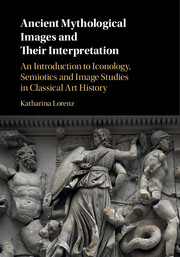 Ancient Mythological Images and their Interpretation
Ancient Mythological Images and their Interpretation from ICONOLOGY
Published online by Cambridge University Press: 05 August 2016
The analysis here proceeds in two stages that encompass the Panofskyan three-step model. At the iconographic stage, the focus is first on the depicted characters, their attire, and their relation to each other and to other pictorial elements, and then, in a second step, these elements are compared with other visual and textual versions of the myth. At the iconological stage, the specific rendering of the mythological story as presented in the pictures is contextualised within its historical setting.
The Karlsruhe hydria: conflict, consolation, and Athens
An iconographic analysis.
The figure of the Trojan prince Paris (Alexandros) in the upper picture field, the character judging over the fairest of the Olympian goddesses, is at the centre of the hydria's iconographic peculiarities requiring explanation (fig. 0.1). He is dressed in Oriental clothes, with soft cap, richly patterned tunic and trousers, and with a dagger featuring a bird's head hilt hanging from a baldric across his upper body. The lagobolon, a hunting utensil, in his left hand identifies him as a figure of the outdoors and as a shepherd, as do also the landscape setting and the dog at his feet.
The picture's nucleus shows Paris in negotiation with Hermes and Eros (fig. 5.1). The prince's hand gesture towards Eros, with thumb and index finger of the right meeting, seemingly expresses approval. The three goddesses are arranged around this group. Athena is on the left in full armour, including an Attic helmet with horse protomes and the aegis. The woman standing further to the left is Hera, here lifting her garment in a way reminiscent of the aidos motif. Aphrodite, in contrast, is depicted seated towards the right of the nucleus; she is accompanied by another Eros, who mimics the stance of the Eros standing next to Paris.
The scene on the Karlsruhe hydria differs in two aspects from earlier representations of the Judgement, which enjoyed considerable popularity in sixth- and fifth-century black- and red-figure Athenian vase-painting. The first contrast concerns the characterisation of the participants, their appearance, and their actions. In archaic and early classical versions, the three goddesses were distinguished, if at all, by their attributes.
To save this book to your Kindle, first ensure [email protected] is added to your Approved Personal Document E-mail List under your Personal Document Settings on the Manage Your Content and Devices page of your Amazon account. Then enter the ‘name’ part of your Kindle email address below. Find out more about saving to your Kindle.
Note you can select to save to either the @free.kindle.com or @kindle.com variations. ‘@free.kindle.com’ emails are free but can only be saved to your device when it is connected to wi-fi. ‘@kindle.com’ emails can be delivered even when you are not connected to wi-fi, but note that service fees apply.
Find out more about the Kindle Personal Document Service.
To save content items to your account, please confirm that you agree to abide by our usage policies. If this is the first time you use this feature, you will be asked to authorise Cambridge Core to connect with your account. Find out more about saving content to Dropbox.
To save content items to your account, please confirm that you agree to abide by our usage policies. If this is the first time you use this feature, you will be asked to authorise Cambridge Core to connect with your account. Find out more about saving content to Google Drive.